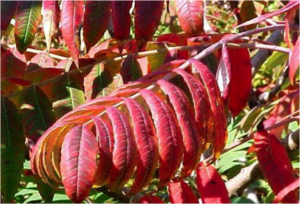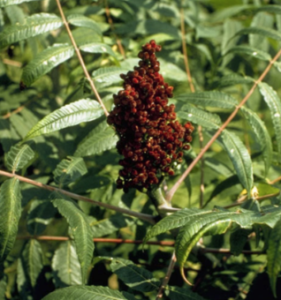Common Name: Smooth Sumac
Specific Name: Rhus glabra
Known Occurrence at Taylor Point:
Map Areas: Beach 1E
Category: Native, Shrub

Ecological Considerations:
Rhus glabra, commonly known as smooth sumac, is a native, colony-forming, deciduous shrub that occurs on fields, abandoned farmland, clearings and along roads. Smooth sumac forms thickets from root suckers.
The stems and branches are hairless and covered with a whitish waxy coating. The leaves are alternate and pinnately compound (3-5 dm long). Smooth sumac has 11-31 leaflets that are lanceolate to oblong-lanceolate (7-9 cm long). The leaflets taper to a point at the tip and are rounded at the base. The margins are sharply serrated. The upper surface is dark green and lustrous. The lower surface is covered with a whitish waxy coating. Smooth sumac has a branched, racemose inflorescence with flowers maturing from the bottom up (10-25 cm long). Tiny, yellowish-green flowers bloom in terminal panicles (5-10″ long) in late spring to early summer, with separate male and female flowers appearing on separate plants (dioecious).
The drupes have a flattened-globe shape (3.5-4.5 mm long) and are covered with red, sticky hairs. The seeds are yellowish in color and smooth (3-3.5 mm long).
Smooth sumac is very similar to staghorn sumac (R. typhina), except the young stems of staghorn are densely pubescent whereas those of this species are smooth, hence the common name.
Map areas where this plant can be used for revegetation:
Map areas: Woodland 3C
Propagation Mechanisms/Strategies for Encouraging its Establishment:
Propagation of smooth sumac can occur by use of seeds or root cuttings. Seeds germinate best when exposed to continuous light and alternating warm and cool temperatures. Smooth sumac grows best in poor, well-drained soils, with partial to full sun. However, smooth sumac is a hardy species and will tolerate many soil types including soil that is slightly saline.
Sumacs fail to compete with invading tree species and are seldom found growing under a closed canopy.
Best Planting Practices/Options and Pros and Cons of Options:
Smooth sumac grows in average, dry to medium moisture, well-drained soil in full sun to part shade. It is tolerant of wide range of soils except those that are poorly drained.
Key Issues Regarding its Ecology:
Associated Ecological Benefits: Fruit is attractive to butterflies, and birds. Plant is of special value to native bees and honeybees.
Availability of Locally Sourced Seeds and Plants:
Wildwood Nurseries http://wildwoodri.com
Edge of the Woods Native Plant Nursery- Orefield, PA
http://edgeofthewoodsnursery.com
ArcheWild Native Nursery- Quakertown, PA www.ArcheWild.com
Case Studies of Native Plant Establishment Efforts/Lessons Learned:
Additional Photos:


Sources cited:
URI Native Plants
USDA
Missouri Botanical Garden
Lady Bird Johnson Wildflower Center
Key Words:
Native
shrub
Smooth Sumac
Rhus glabra
root suckers
dioecious
colony-forming
Beach
1E
